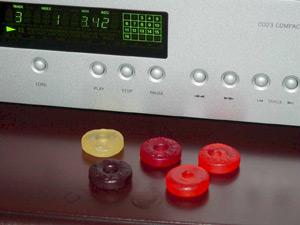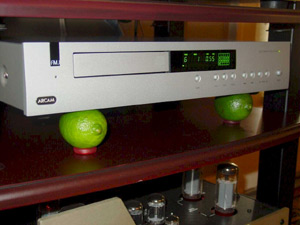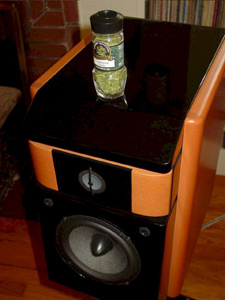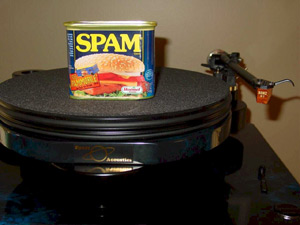![[SoundStage!]](../sslogo3.gif) Audio Hell Audio HellBack Issue Article |
June 2003 Brilliant Pebbles, Gifted Avocado Pits, and a Fairly Smart Can of Spam Dumb as a sack of rocks! That was my initial take when a friend of mine asked if I had heard about the latest audio tweak -- Brilliant Pebbles. This I gotta see. Jumping to the keyboard, I immediately brought up my old buddy Google and typed in the magic words. Expecting my search to come up empty, I was quite taken aback when site after site was listed on my screen. I clicked the first link. "Brilliant Pebbles is a space-based, kinetic-energy weapon concept under development in the United States by the Ballistic Missile Defense Organization. Approximately 4600 small interceptors would be deployed in orbit, each capable of homing in on and destroying incoming hostile warheads." I knew it, I knew it! The government just couldn’t keep their hands off of high-end audio. Now that the defense industry is involved we’ll see some real improvements. I tried again. "Brilliant edible pebbles and glitter for cake decorating and candy making." Edible rocks? What is it about humans that make us want to create edible versions of every imaginable object that we would never consider as a food source. I myself have partaken of edible likenesses of worms, spiders, dog doo, vomit, and dirt. I guess it’s another one of those things that separates us from apes. "Brilliant Pebbles is a new and unique concept for improving the sound of any audio system." There we have it! For only $99 you get a small three-inch bottle that contains selected minerals/stones specially prepared for maximum effectiveness." Thank goodness for that. I would hate to think that I had wasted my money on something that had only been prepared for minimum, or even medium, effectiveness. Machina Dynamica, a Virginia-based company, is a manufacturer of several "vibration isolation & resonance control solutions," including Brilliant Pebbles. They claim that their jar of rocks work through both electromagnetic absorption and energy dissipation. Put them in corners, on top of speakers, above output transformers, on your amp, preamp or CD player. They claim effectiveness can be provided in numerous locations. Now I have to admit some hesitation here. Looking at the picture I saw a small jar, used for canning jams or jellies, filled to the top with some pretty polished stones. My grandfather was what is commonly called a "rock hound," and I saw many such jars in his basement. But I seriously doubt that his were "specially prepared." Before you go thinking that this column is all about making fun of a finely tuned jar of rocks, let me say this. Without even spending a dollar, I’m willing to bet that Brilliant Pebbles work. They will change the sound of your system. For the good or for the bad, that’s not for me to say. What I can say is that virtually every vibration, isolation, resonance control device I’ve ever tried did do something. Different materials have different resonance frequencies. Different shapes also have an effect. These devices change the resonance frequency of the component. Some also create a resonance of their own. For more on this, see Doug Blackburn’s column "Exploding the Myth of the Cone Footer." But wait! If a jelly jar full of rocks can make a difference, what else do I have around the house that could transform my system. It was with this flash of brilliance that I headed for the kitchen. The pantry "What’s ya looking for darlin'? Dinner didn’t fill you up?" What could I say? The love of my life has always been so patient. She did begin to question my sanity when she saw me eyeing the 10" circles of cooking parchment at a local gourmet store. Her dreams of my creative cookery died when I told her how perfect they would be for small VTA adjustments on the turntable. Did I want to test her tolerance further? "Oh, I don’t know. I’ve got a craving for something. Just can’t quite figure out what it is." Chicken. As she disappeared into the TV room, I began to load my arms with possible audio condiments. Jars of various spices, bags of Mahatma rice, and buried like a couple of undiscovered gems: two cans of Spam. A quick trip to the refrigerator revealed other possibles. Three limes as well as a trio of avocados smelled optimistic. They also smelled like the batch of guacamole I had consumed the night before. I bypassed the chips and headed for the listening room. Freshly grown footers Processed or organic? Having received a couple of health-related magazine subscriptions from my mother-in-law recently, I was fully aware of the benefits of avoiding processed foods. I guess this means she wants me around for awhile. It pays to stay on the good side of your wife’s mother. With this knowledge in hand, I decided to go with organic.
My first dilemma presented itself when I tried to balance my Arcam FMJ CD23 on top a trio of avocados. No matter where I placed the avocados, the player kept jumping around like a low-rider '63 Impala in a Cinco de Mayo parade. Returning to the pantry, I found just the ticket. There nestled in my sugar stash was a bag of Lifesaver Gummies. These flexible little candies have a consistency similar to sorbothane. I placed one under each avocado and my player relaxed into a nice siesta. Siesta is right! Compared to the untreated player, the sound immediately became mushy and lethargic. Yes, the top end gained a slightly creamy texture (I wonder if any of that guacamole is left) but at the expense of everything else. The bass was loose and the midrange much too smooth. Too ripe. Great for salad, bad for sound. I returned the fruit to the kitchen. That’s right -- fruit, not vegetable. I also learned of the avocado’s association with the erotic. Apparently the avocado has a centuries-old reputation as an aphrodisiac. It seems that the ancient Aztecs called the avocado tree "Ahuacuatl," which roughly translates into a part of the male anatomy that most resembles a pair of the fruit hanging in a tree. Legend also has it that young women were confined indoors during the harvest of this erotic fruit. I’ll never look at guacamole the same way. After learning of the heated roots of this little green machine, you can imagine my disappointment with the sonic results. How could such a sexy beast sound so blah? I had one more idea. Grabbing my favorite piece of kitchen cutlery (yes, I’m a Food Channel addict), I performed a series of quick surgeries revealing three quite slippery pits. After drying them off a bit, I returned them to their position on the Lifesaver pucks.
Next up were the limes. I had almost convinced myself of the scientific superiority of this fruit before I tried it. Looking at the various layers of the fruit I was sure this would have a positive effect on its resonance-control properties. Switching to the limes proved quite interesting. It was as if the singer took a couple of steps forward. The midrange wasn’t exactly in your face, but it did draw my attention. I couldn’t say that the bass became tighter or looser; it just became less prominent. In my system, the limes didn’t work. In a system that’s a little too reticent and laid-back in the midband, the limes might provide just the juice you need. I didn’t quite know where rice fit in this scheme. Yes, it’s organic, yet it’s also packaged. Mahatma Extra Long Grain Enriched Rice. Not quite sure what "enriched" is all about. Regardless of its humble origins, rice proved to be a useful tweak in a number of ways. I first tried the rice by placing the bags on top of the player, with the avocados or limes still in place. The result was positive in both instances. Whether using the avocado pits or the limes, the result was the same. There seemed to be less grain (ha!) and quieter backgrounds in the music. All other differences between the two organic footers remained the same. Removing the footers and placing the rice underneath changed everything. The bass became more full, yet not as tight. Imaging and focus became less precise. The entire sound became rounder. I added a couple of bags to the top as well and things seemed to tighten a bit, but were still not as precise as with the footers. Perhaps short-grain or wild rice would be better.
In the information regarding its Brilliant Pebbles, Machina Dynamica mentions placing the jars on top of speaker cabinets. Having experimented with the "beaks" manufactured by Totem, the speaker company, I was not surprised by this claim. When I first tried the Totem beaks, I was unsure if I was hearing a benefit. I kept them on for some time and then removed them. Upon their removal, I immediately noticed a loss of ambient information. There was a loss of spaciousness that was there before. I was never sure how accurate the added ambience was, but it did exist. Instead of Brilliant Pebbles or beaks, I chose something with a little more flavor. Like most kitchens, ours has accumulated an endless supply of bottles, tins, and cans of various spices. Looking through our collection, I found several bottles about the same three-inch stature as the Pebbles jar. Let me jump to the conclusion here and say that the results of my spice jars were very similar to what I remembered with the beaks. The added spatial twist is quite intriguing. I just don’t know if it’s accurate or an artifact, but at $3 a bottle, who cares? Does the spice inside make a difference? I didn’t think so, although I consciously picked the cayenne and peppercorns over less-heated choices. Perhaps you could make an entire audio spice rack. Basil with Bach. Sage with Sinatra. Spam? And what of the can of mystery meat? Surely it performed sonic wonders beyond any tweak yet invented. Well, I’m afraid it will have to be satisfied with the legendary status it has achieved on the screen with Monty Python. After trying it under the player, on top of the player, or sitting upon the speaker cabinets, I have determined its benefit to be exactly the same to the audio world as it is to the culinary world. I prefer bologna.
...Bill Brooks
|
|
![[SoundStage!]](../sslogo3.gif) All Contents All ContentsCopyright © 2003 SoundStage! All Rights Reserved |
 Since source components always
seem to show the greatest gains, I focused on the CD player.
Since source components always
seem to show the greatest gains, I focused on the CD player.  The difference was immediate
and amazing. The life had returned. Gone was the sluggish indistinct bass. Compared to the
untreated player, the sound was even more focused, the imaging more precise. There still
was a smoothness to the top end, yet the sound was alive and vibrant. The legendary powers
of the avocado continued to grow.
The difference was immediate
and amazing. The life had returned. Gone was the sluggish indistinct bass. Compared to the
untreated player, the sound was even more focused, the imaging more precise. There still
was a smoothness to the top end, yet the sound was alive and vibrant. The legendary powers
of the avocado continued to grow. Audio seasonings
Audio seasonings So what does this all add up
to? Well, you can spend $99 on a jar of rocks and you won’t hear a negative word from
me. My cabinet is filled with cones, pods, and footers that add up to considerably more
green than that. It all does something, that’s for sure. You can look in your pantry
or refrigerator, but you better check labels for freshness. Or you might just want to look
around the house and experiment a little. It might not have a cool audiophile name or a
white paper full of engineer-speak, but you might just save enough money to go out for
lunch a little more often and let the Spam remain hidden in the back of the cupboard. Food
for thought….
So what does this all add up
to? Well, you can spend $99 on a jar of rocks and you won’t hear a negative word from
me. My cabinet is filled with cones, pods, and footers that add up to considerably more
green than that. It all does something, that’s for sure. You can look in your pantry
or refrigerator, but you better check labels for freshness. Or you might just want to look
around the house and experiment a little. It might not have a cool audiophile name or a
white paper full of engineer-speak, but you might just save enough money to go out for
lunch a little more often and let the Spam remain hidden in the back of the cupboard. Food
for thought….